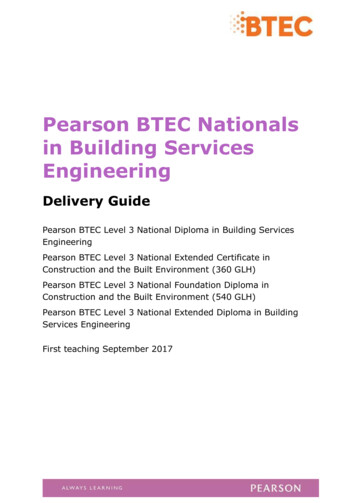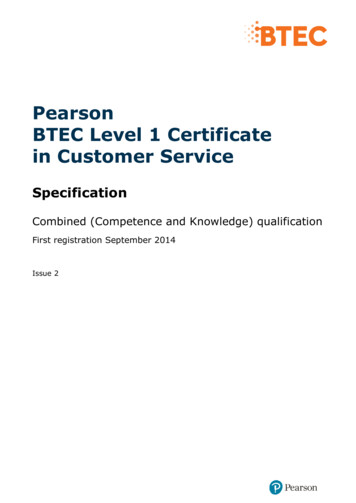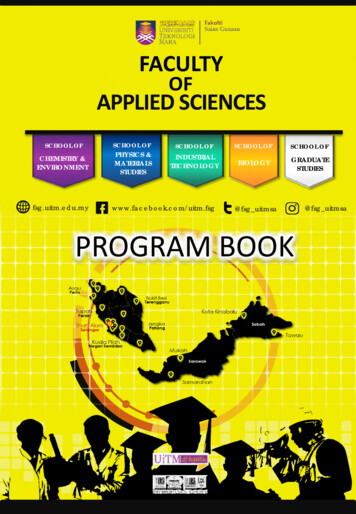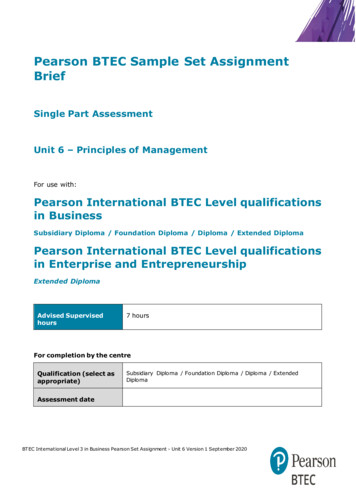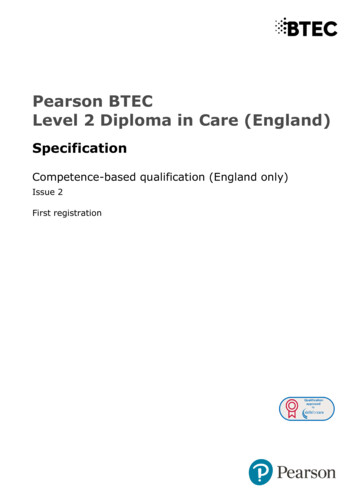
Transcription
Pearson BTECLevel 2 Diploma in Care (England)SpecificationCompetence-based qualification (England only)Issue 2First registration
Edexcel, BTEC and LCCI qualificationsEdexcel, BTEC and LCCI qualifications are awarded by Pearson, the UK’s largest awardingbody offering academic and vocational qualifications that are globally recognised andbenchmarked. For further information, please visit our qualifications website atqualifications.pearson.com. Alternatively, you can get in touch with us using the details onour contact us page at qualifications.pearson.com/contactusAbout PearsonPearson is the world's leading learning company, with 35,000 employees in more than70 countries working to help people of all ages to make measurable progress in their livesthrough learning. We put the learner at the centre of everything we do, because whereverlearning flourishes, so do people. Find out more about how we can help you and yourlearners at qualifications.pearson.comThis specification is Issue 2. Key changes are listed in the summary table on the next page.We will inform centres of any changes to this issue. The latest issue can be found on thePearson website: qualifications.pearson.comReferences to third-party material made in this specification are made in good faith. Pearsondoes not endorse, approve or accept responsibility for the content of materials, which maybe subject to change, or any opinions expressed therein. (Material may include textbooks,journals, magazines and other publications and websites.)All information in this specification is correct at time of publication.ISBN 978 1 446 96024 0All the material in this publication is copyright Pearson Education Limited 2019
Pearson BTEC Level 2 Diploma in Care (England)specification Issue 2 changesSummary of changes made between previous issue and thiscurrent issueGroup B1 optional units 57-62 added including the following:Unit 57 Understand how to support individuals during the last days oflifeUnit 58 Understand advance care planningUnit 59 Provide support for journeysUnit 60 Understand models of disabilityUnit 61 The principles of infection and controlUnit 62 Understand the process and experience of dementiaGroup B2 optional units 63-88 added including the following:Unit 63: Support independence in the tasks of daily livingUnit 64: Support effective communication with individuals with asensory lossUnit 65: Equality, diversity and inclusion in dementia care practiceUnit 66: Provide active supportUnit 67: Supporting individuals with loss and grief before deathUnit 68: Managing symptoms in end of life careUnit 69: Recognise indications of substance misuse and referindividuals to specialistsUnit 70: Identify and act upon immediate risk of danger to substancemisusersUnit 71: Increase awareness about drugs, alcohol or other substanceswith individuals and groupsUnit 72: Carry out initial assessments to identify and prioritise theneeds of substance misusersUnit 73: Carry out comprehensive substance misuse assessmentUnit 74: Assist with the transfer of individuals, who misuse substances,between agencies and servicesUnit 75: Develop and sustain effective working relationships with staffin other agenciesUnit 76: Supply and exchange injecting equipment for individualsUnit 77: Facilitate learning and development activities to meetindividual needs and preferencesUnit 78: Support individuals to access and use services and facilitiesUnit 79: Support individuals to maintain personal hygieneUnit 80: Supporting infection prevention and control in social careUnit 81: Support individuals to live at homeUnit 82: Provide support for individuals within a shared livesarrangementUnit 83: Contribute to raising awareness of health issuesUnit 84: Meet food safety requirements when providing food and drinkfor individualsUnit 85: Support individuals with specific communication needsUnit 86: Support care plan activitiesUnit 87: Administer medication to individuals and monitor the effectsUnit 88: Test for substance useUnit 7: Implement person-centred approached in care setting. The 6Csthe word ‘choice’ has been replaced with ‘communication’.SectionnumberSection 4Section 4Section 11Earlier issue(s) show(s) previous changes.If you need further information on these changes or what they mean, contact us via our websiteat: tml.
Contents1Introducing BTEC Competence-based qualificationsfor the New Apprenticeship Standards1Overview1Sizes of Competence-based qualifications12Qualification summary and key information33Qualification purpose4Qualification objectives4Relationship with previous qualifications5Apprenticeships5Progression opportunities5Industry support and recognition5Qualification structure6Pearson BTEC Level 2 Diploma in Care (England)645Programme delivery11Elements of good practice11Delivery guidance for Pearson BTEC Level 2 Diploma in Care(England)126Centre resource requirements147Access and recruitment16Prior knowledge, skills and understanding16Access to qualifications for learners with disabilities or specific needs 1689Assessment17Language of assessment17Internal assessment17Assessment strategy18Assessment of knowledge and understanding20Appeals21Dealing with malpractice21Internal assessment21Learner malpractice22Teacher/centre malpractice22Sanctions and appeals23Reasonable adjustments to assessment23Special consideration24Centre recognition and approvalCentre recognition2525
Approvals agreement2510 Quality assurance2611 Unit format27Unit number27Unit title27Unit reference number27Level27Unit type27Credit value27Guided Learning Hours (GLH)27Unit summary27Learning outcomes28Assessment criteria28Unit content28Relationship between unit content and assessment criteria28Legislation28Information for tutors28Units29Unit 1:Communication in Care Settings31Unit 2:Personal Development in Care Settings39Unit 3:Equality and Inclusion in Care Settings47Unit 4:Duty of Care55Unit 5:Safeguarding and Protection in Care Settings61Unit 6:Responsibilities of a Care Worker75Unit 7:Implement Person-centred Approaches in Care Settings82Unit 8:Health, Safety and Wellbeing in Care Settings92Unit 9:Handle Information in Care Settings10712 Further information and useful publications11313 Professional development and training11414 Contact us115Annexe A: Assessment strategy117
1Introducing BTEC Competence-basedqualifications for the New ApprenticeshipStandardsOverviewIn October 2013, the government began the implementation of the plan to reformapprenticeships in England. The reform includes changes that move the design ofapprenticeships into the hands of employers with the aim of making them morerigorous and responsive to employers’ needs. Employer groups, referred to asTrailblazers, now lead on the development of apprenticeships for occupations wherethey identify the need for apprentices.Pearson has been working closely with Trailblazer employer groups in thedevelopment of different types of assessment programmes and qualifications tosupport the delivery of these new apprenticeships. Employers are continuing tovalue competence-based qualifications as a part of these new apprenticeships.Within the new apprenticeships, competence-based qualifications give learners theopportunity to develop and demonstrate their competence, in line with theApprenticeship Standards developed by Trailblazer employer groups. These newApprenticeship Standards describe the knowledge, skills and behaviours (KSBs)required to undertake a specific occupation well, and to operate confidently within asector. They focus on how an apprentice should demonstrate mastery of anoccupation and, where they exist, meet sector professional registrationrequirements.Competence-based qualifications are outcome based with no fixed learningprogramme, therefore allowing flexible delivery to meet the individual needs oflearners and their employers. Learners will work towards their qualificationsprimarily in the workplace or in settings that replicate the working environment asspecified in the assessment requirements from the Trailblazer employer groups.Employers, or colleges and training centres, working in partnership with employers,can offer these qualifications as long as they have access to appropriate physicaland human resources and that the necessary quality-assurance systems are inplace.Learners can take the Pearson BTEC Level 2 Diploma in Care (England) as astand-alone qualification outside of an apprenticeship if they wish.Sizes of Competence-based qualificationsFor all regulated qualifications, Pearson specify a total number of hours that it isestimated learners will require to complete and show achievement for thequalification – this is the Total Qualification Time (TQT). The TQT value indicatesthe size of a qualification.Within the TQT, Pearson identifies the number of Guided Learning Hours (GLH) thatwe estimate a centre delivering the qualification might provide. Guided learningmeans activities, such as lessons, tutorials, online instruction, supervised study andgiving feedback on performance, that directly involve tutors and assessors inteaching, supervising and invigilating learners. Guided learning includes the timerequired for learners to complete external assessment under examination orsupervised conditions.Pearson BTEC Level 2 Diploma in Care (England) –Specification – Issue 2 – February 2019 Pearson Education Limited 20191
In addition to guided learning, other required learning directed by tutors orassessors will include private study, preparation for assessment and undertakingassessment when not under supervision, such as preparatory reading, revision andindependent research.As well as TQT and GLH, qualifications can also have a credit value – equal to onetenth of TQT, rounded to the nearest whole number.TQT and credit values are assigned after consultation with users of thequalifications.Competence-based qualifications for the New Apprenticeship Standards aregenerally available in the following sizes: Award – a qualification with a TQT value of 120 or less(equivalent to a range of 1–12 credits) Certificate – a qualification with a TQT value in the range of 121–369(equivalent to a range of 13–36 credits) Diploma – a qualification with a TQT value of 370 or more(equivalent to 37 credits and above).Other size references, such as the Extended Diploma, can be used in a suite ofqualifications depending on the specific needs of different sectors and Trailblazeremployer groups.2Pearson BTEC Level 2 Diploma in Care (England)Specification – Issue 2 – February 2019 Pearson Education Limited 2019
2Qualification summary and key informationQualification titlePearson BTEC Level 2 Diploma in Care(England)Qualification Number (QN)603/2762/5Regulation start date06/12/2017Operational start date01/01/2018Approved age ranges16–1819 Please note that sector-specific requirements orregulations may prevent learners of a particular agefrom embarking on this qualification. Please refer tothe assessment requirements in Section 8Assessment.Total Qualification Time (TQT)460 hoursGuided Learning Hours (GLH)317Credit value46AssessmentPortfolio of evidence (internal assessment).Grading informationThe qualification and units are graded pass/fail.Entry requirementsNo prior knowledge, understanding, skills orqualifications are required before learners register forthis qualification.Centres must also follow the Pearson Access andRecruitment policy (see Section 7 Access andrecruitment).FundingThe new Apprenticeship Standard funding rules canbe found on the Skills Funding Agency's website esCentres will need to use the Qualification Number (QN) when they seek publicfunding for their learners. The qualification title, unit titles and QN will appear oneach learner’s final certificate. Centres should tell learners this when recruitingthem and registering them with Pearson. There is more information aboutcertification in our UK Information Manual, available on our website,qualifications.pearson.comPearson BTEC Level 2 Diploma in Care (England) –Specification – Issue 2 – February 2019 Pearson Education Limited 20193
3Qualification purposeQualification objectivesThe Pearson BTEC Level 2 Diploma in Care (England) is for learners employed as anapprentice in the role of an adult care worker (can include personal assistants) orhealthcare support worker (can include healthcare assistant, nursing assistant ornursing auxiliary).An adult care worker’s role in care is to make a positive difference to someone’s lifewhen they are faced with physical, practical, social, emotional or intellectualchallenges. Adult care workers need to have the right values and behaviours,developing competences and skills to provide high-quality compassionate care andsupport. They are the frontline staff who help individuals with care and supportneeds to achieve their personal goals and live as independently and safely aspossible, enabling them to have control and choice in their lives, which is at theheart of person-centred care. Job roles are varied and determined by, and relevantto, the type of service being provided and the person supported. Adult care workersmay work in residential or nursing homes, domiciliary care, day centres, a person’sown home or some clinical healthcare settings.Personal assistants do the same job as an adult care worker and work directly forone individual, usually within their own home.Healthcare Support Workers (HCSWs) work as part of a team providing high-qualityand compassionate care to individuals requiring care and support, and may includepatients, service users or clients. They carry out well-defined routine clinical dutiessuch as monitoring an individual’s conditions (by checking things like bloodpressure, temperature or weight), and checking on their overall progress, comfortand wellbeing. Depending on where they work, they may also help them to eat,drink, wash, dress or go to the toilet.Healthcare Support Workers will prepare individuals for healthcare activities carriedout by other members of the healthcare team, looking after them before, duringand/or after those activities in line with their care plan. They will also carry outnon-clinical duties and, depending on where they work, this could include thingslike keeping records, making beds, tidying up the work area, returning or cleaningthe equipment used during a clinical activity. Healthcare Support Workers work in arange of healthcare settings and their team may include workers from both healthand social care. They report to a registered healthcare practitioner, who will directlyor indirectly supervise their work.The qualification gives learners the opportunity to: 4develop the fundamental technical skills and underpinning knowledge andunderstanding required to become competent in the job role. These cover thefollowing areas: communication, personal development, equality and inclusion,duty of care, safeguarding, person-centred approaches, health and safety andhandling information. Learners will also be expected to work effectively as partof a team and within agreed ways of working, following the relevant standards,policies and protocols used in their workplace, including the Code of Conduct forAdult Social Care Workers and Healthcare Support Workers in England. Fordetails of the units included in this qualification, please see Section 5Qualification structurePearson BTEC Level 2 Diploma in Care (England)Specification – Issue 2 – February 2019 Pearson Education Limited 2019
develop appropriate professional attitudes and behaviours that will supportpersonal success in their job role and the long-term success of theirorganisation develop a range of interpersonal and intrapersonal skills to support progressionto, and success in, further study and career advancement achieve a nationally-recognised Level 2 qualification.Relationship with previous qualificationsThis qualification replaces the Pearson Edexcel Level 2 Diploma in Health and SocialCare (Adults) for England, expiry date 31 December 2017.ApprenticeshipsThe Level 2 Diploma in Care (England) is a mandatory requirement within the AdultCare Worker Apprenticeship Standard. Learners must achieve this qualification,together with all other specified requirements of the Apprenticeship Standard,before progressing to the End-point Assessment. The Pearson BTEC Level 2Diploma in Care fulfils this mandatory requirement.The published Adult Care Worker Apprenticeship Standard and Assessment Plan canbe found at: -standards/adultcare-worker/The Level 2 Diploma in Care (England) is not a mandatory requirement within theHealthcare Support Worker Apprenticeship Standard. However, learners may takethis qualification if required by employers. Learners must achieve the specifiedrequirements of the Healthcare Support Worker Apprenticeship Standard beforeprogressing to the End-point assessment.The published Healthcare Support Worker Apprenticeship Standard and AssessmentPlan can be found at: standards/healthcare-support-worker/Progression opportunitiesLearners who achieve the Pearson BTEC Level 2 Diploma in Care (England) can,having achieved all other specified requirements of the relevant ApprenticeshipStandard, progress to achieving the full Apprenticeship certification that confirmscompetency in the job role stated on the previous page.Learners can then choose to progress to the Level 3 Lead Adult Care WorkerApprenticeship, higher level qualifications in care or specialist qualificationsreflecting the context in which they work.Achievement of the Level 2 qualification, together with additional training, can alsosupport progression to job roles that require a more complex set of skills andresponsibility, e.g. lead adult care worker, lead personal assistant.Industry support and recognitionThe Pearson BTEC Level 2 Diploma in Care (England) was developed through closecollaboration with Skills for Care, part of the Sector Skills Council Skills for Care andDevelopment.This qualification is supported by Skills for Care and Skills for Health and isrecognised by the Adult Care Trailblazer Group and the Healthcare TrailblazerGroup as an appropriate qualification to support the Adult Care Worker andHealthcare Support Worker Apprenticeship Standards.Pearson BTEC Level 2 Diploma in Care (England) –Specification – Issue 2 – February 2019 Pearson Education Limited 20195
4Qualification structurePearson BTEC Level 2 Diploma in Care (England)Learners will need to meet the requirements outlined in the table below before thequalification can be awarded.Minimum number of credits that must be achieved46Number of mandatory credits that must be achieved24Number of optional credits that must be achieved22Minimum number of credits that must come from Group B1 – OptionalContext or Specialist Knowledge Units2Maximum number of credits that must come from Group B1 – OptionalContext or Specialist Knowledge Units715Minimum number of credits that must come from Group B2 – OptionalCompetence Units (if less than 7 credits have been achieved in GroupB1, learners will need to achieve more than the minimum 15 credits fromGroup B2 to ensure the overall credits for the optional units is minimumof 22 credits).Please note that Unit 29 Administering medication to individualsand Unit 87 Administer medication to individuals and monitor theeffects are a barred combination of delivery.UnitnumberMandatory unitsLevelCreditGuidedlearninghours1Communication in Care Settings23202Personal Development in Care Settings23233Equality and Inclusion in Care Settings22174Duty of Care2175Safeguarding and Protection in Care Settings23266Responsibilities of a Care Worker22167Implement Person-centred Approaches inCare Settings25398Health, Safety and Wellbeing in Care Settings24339Handle Information in Care Settings21106Pearson BTEC Level 2 Diploma in Care (England)Specification – Issue 2 – February 2019 Pearson Education Limited 2019
UnitnumberOptional Group B1 –Context or SpecialistKnowledge unitsLevelCreditGuidedlearninghours10Understand Mental Wellbeing and MentalHealth Promotion332011Understand Mental Ill Health331612Principles of the Mental Capacity Act 2005332013Awareness of Dementia221714The Person-Centred Approach to the Careand Support of Individuals with Dementia221715Understanding the Role of Communicationand Interactions with Individuals who haveDementia332616Introduction to Personalisation in Care332617Causes and Spread of Infection222018Cleaning, Decontamination and WasteManagement222019Understanding the Context of SupportingIndividuals with Learning Disabilities243520Principles of Positive Risk Taking forIndividuals with Disabilities222021Awareness of Autistic Spectrum Conditions221722Introduction to Physical Disability221923Introduction to the Impact of Acquired BrainInjury on Individuals232524Awareness of Sensory Loss221625Understanding How to Work in End of LifeCare232826Recognising and Managing the Symptoms ofStroke232827Awareness of Diabetes364628Understand Parkinson’s for Care staff321457Understand how to support individuals duringthe last days of life332858Understand advance care planning332559Provide support for journeys221760Understand models of disability332661The principles of infection prevention andcontrol233062Understand the process and experience ofdementia3322Pearson BTEC Level 2 Diploma in Care (England) –Specification – Issue 2 – February 2019 Pearson Education Limited 20197
UnitnumberOptional Group B2 – Competence unitsLevelCreditGuidedlearninghours29Administering Medication to Individuals352530Providing Support for Therapy Sessions231831Provide Support to Manage Pain andDiscomfort221532Contributing to Monitoring the Health ofIndividuals Affected by Health Conditions221833Supporting Individuals to Carry Out theirOwn Healthcare Procedures221534Support Individuals to Access and UseInformation about Services and Facilities232035Supporting Individuals who are Distressed232136Supporting Individuals to Eat and Drink221537Support Individuals to Meet Personal CareNeeds221638Support Individuals to Manage Continence231939Providing Agreed Support for Foot Care232340Undertake Agreed Pressure Area Care243041Obtain and Test Capillary Blood Samples343042Obtaining and Testing Specimens fromIndividuals221543Safe Movement and Handling of Individualsin Accordance with Own Care Plan242644Working in Partnership with Families toSupport Individuals342745Promoting Positive Behaviour364446Supporting Families of Individuals withAcquired Brain Injury232447Contribute to Supporting Individuals in theUse of Assistive Technology232048Prepare for and Take PhysiologicalMeasurements332349Contribute to the Effectiveness of Teams inCare Settings232050Promoting Nutrition and Hydration in CareSettings34328Pearson BTEC Level 2 Diploma in Care (England)Specification – Issue 2 – February 2019 Pearson Education Limited 2019
UnitnumberOptional Group B2 – Competence unitsLevelCreditGuidedlearninghours51Assessing the Needs of Carers and Families342852Monitoring and Maintaining theEnvironment and Resources during andafter Healthcare Activities232053Support Individuals Undergoing HealthcareActivities232254Prepare Individuals for HealthcareActivities22955Assist the Practitioner to Carry outHealthcare Activities221356Select and Wear Appropriate PersonalProtective Equipment for Work inHealthcare Settings221563Support independence in the tasks of dailyliving253364Support effective communication withindividuals with a sensory loss232365Equality, diversity and inclusion indementia care practice343166Provide active support232767Supporting individuals with loss and griefbefore death321568Managing symptoms in end of life care332269Recognise indications of substance misuseand refer individuals to specialists342470Identify and act upon immediate risk ofdanger to substance misusers342471Increase awareness about drugs, alcoholor other substances with individuals andgroups374272Carry out initial assessments to identifyand prioritise the needs of substancemisusers353073Carry out comprehensive substance misuseassessment353074Assist with the transfer of individuals, whomisuse substances, between agencies andservices316Pearson BTEC Level 2 Diploma in Care (England) –Specification – Issue 2 – February 2019 Pearson Education Limited 20199
UnitnumberOptional Group B2 – Competence unitsLevelCreditGuidedlearninghours75Develop and sustain effective workingrelationships with staff in other agencies342476Supply and exchange injecting equipmentfor individuals331877Facilitate learning and developmentactivities to meet individual needs andpreferences353578Support individuals to access and useservices and facilities342579Support individuals to maintain personalhygiene221780Supporting infection prevention and controlin social care321881Support Individuals to Live at Home342582Provide support for individuals within ashared lives arrangement353583Contribute to raising awareness of healthissues342684Meet food safety requirements whenproviding food and drink for individuals221585Support individuals with specificcommunications needs353586Support care plan activities221387Administer medication to individuals andmonitor the effects353088Test for substance use3530Unit selection guidanceTo meet the eligibility requirements for the qualification, learners have to chooseoptional units from two groups: context or specialist knowledge units (Group B1)and competence units (Group B2). Within each group, there are a number of unitsacross a number of specialisms to accommodate the varying needs of learners.Centres must deliver appropriate combinations of specialist units across the twooptional groups to meet the needs and work context of individual learners.10Pearson BTEC Level 2 Diploma in Care (England)Specification – Issue 2 – February 2019 Pearson Education Limited 2019
5 Programme deliveryCentres are free to offer these qualifications using any mode of delivery that meetslearners’ and employers’ needs.A learner must be employed as an apprentice in the job role specified in theApprenticeship Standard and have an apprenticeship agreement in place at thestart of the apprenticeship programme. Centres must make sure that learners haveaccess to specified resources and to the sector specialists delivering and assessingthe units. Centres must adhere to the Pearson policies that apply to the differentmodels of delivery. Our policy Collaborative and consortium arrangements for thedelivery of vocational qualifications policy can be found on our website.There are various approaches to delivering a successful, competence-basedqualification; the section below outlines elements of good practice that centres canadopt, as appropriate to the requirements of the apprenticeship programme.Elements of good practice Carrying out a thorough induction for learners to ensure that they completelyunderstand the apprenticeship programme and what is expected of them. Theinduction could include, for example, the requirements of the apprenticeshipprogramme, an initial assessment of current competency levels, assessment ofindividual learning styles, identification of training needs, an individual learningplan, details of training delivery and the assessment process. Having regular progress meetings with the learner to keep them engaged andmotivated, and ensuring that there are open lines of communication among allthose involved in delivering the training and assessment. Using flexible delivery and assessment approaches to meet the needs of thelearner and the organisational context and requirements, through the use of arange of approaches, for example virtual learning environments (VLEs), onlinelectures, video, printable online resources, virtual visits, webcams for distancetraining, e-portfolios. Balancing on-the-job and off-the-job training to meet the requirements of theapprenticeship. It is a mandatory requirement in the new apprenticeships thatlearners have a minimum of 20% or equivalent off-the-job training. Trainersneed to use a range of teaching and learning methods to deliver this trainingeffectively while still meeting varying learner needs. Examples of teaching andlearning methods for off-the-job training could include: enquiry-based learning,real-world problem solving, reflective practice, questioning and discussions,demonstration, practising (‘trial and error’), simulation and role play, peerlearning and virtual environments. Trainers also need to plan opportunities forthe development and practising of skills on the job. The on-the-job element ofthe programme offers opportunities for assessment and plays an important rolein developing the learner’s routine expertise, resourcefulness, craftspersonshipand business-like attitude. It is important that there is intentional structuring ofpractice and guidance to supplement the learning and development providedthrough engagement in everyday work activities. Teaching and learningmethods, such as coaching, mentoring, shadowing, observation, collaborationand consultation, could be used in this structured on-the-job learning.Pearson BTEC Level 2 Diploma in Care (England) –Specification – Issue 2 – February 2019 Pearson Education Limited 201911
Developing a holistic approach to assessment by matching evidence to therequired competencies, as appropriate and, wherever possible, to reduce theassessment burden on learners and assessors. It is good practice to draw up anassessment plan that aligns the competencies to be achieved with the learningprocess and that indicates how and when assessment will take place. Discussing and agreeing with the learner and their line manager suitable times,dates and work areas where assessment will take place. Learners and managersshould be given regular and relevant feedback on p
Employers, or colleges and training centres, working in partnership with employers, can offer these qualifications as long as they have access to appropriate physical and human resources and that the necessary quality -assurance systems are in place. Learners can take the Pearson BTEC Level 2 Diploma in Care (England) as a



